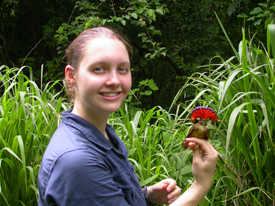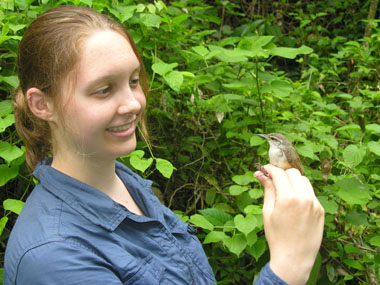
Me holding a male Royal Flycatcher, his crest in full display
|
In
September 2006, I began my Masters program at the University of Windsor
in Dr. Stéphanie Doucet’s lab. Dr.
Doucet’s main research interests lie in avian plumage colouration and sexual
selection (click here to see Dr. Doucet’s homepage).
Sexual
selection is defined by Charles Darwin as “the advantage which certain
individuals have over others of the same sex and species, in exclusive relation
to reproduction.” The term itself
usually conjures up an image of a peacock: a male bird with incredibly
elaborate plumage ornaments which females lack.
This is due to the fact that traditionally, studies of sexual selection
have focused on male ornaments, both visual and acoustic. In this situation, males are the showy sex bearing elaborate ornaments
and females are the choosy, cryptic sex. To date,
there have been few studies of female ornamentation, therefore my Masters
research will focus on ornamentation and mutual sexual selection in the Royal
Flycatcher (Onychorhynchus coronatus).
Royal
Flycatchers are small tyrannid flycatchers which inhabit Central and South America. They
are of great interest to me because both males and females have a crest that
they can display prominently or conceal completely. Males display bright red crests with black
spots, while females display bright yellow crests with black spots. Historically, it has been theorized that
these crests play a role in both mate choice and predator defence
strategies, however no one has studied these phenomena to any great extent.
The goals of my
Masters thesis are to characterize the breeding system of the Royal
Flycatcher and to investigate the signal function of their crests as it
relates to sexual selection.
|

Me holding a Plain Wren
|
From August 2005 to May 2006, I worked on
my Honours thesis at the University
of Windsor in Dr. Daniel
Mennill’s lab. Using recordings made by
multi-channel microphone arrays that had been set up to capture the
vocalizations of one of Dr. Mennill’s study species, the Rufous-and-white Wren
(Thryothorus rufalbus) which had
inadvertently also captured the vocalizations of Plain Wrens (Thryothorus modestus), I characterized the vocalizations of a previously-unstudied population of Plain
Wrens. For more on microphone arrays,
check out both Dr. Mennill’s homepage, and the homepage of one of his graduate
students, Lauren Reed.
Plain
Wrens are neotropical wrens which belong to a group known for their expert singing and
duetting behaviour. They inhabit Central
America, from Mexico to Panama along both the Pacific and the Caribbean slopes.
A population of Plain Wrens inhabiting the Caribbean slope of Central America has previously been studied by Mann et
al. (2003), who found that these wrens sing highly complex duets. This Caribbean
population is believed by some to represent a distinct subspecies of the Plain
Wren, which they refer to as Canebrake Wrens.
These
wrens were recorded in Santa Rosa National Park,
Costa Rica, where the University of Windsor maintains a field house for use
by several researchers. I analyzed
months of recorded data using Syrinx, a program developed by John Burt (University of Washington). With Syrinx, I was able to locate and label
all Plain Wren songs recorded on the multi-channel arrays. Once I had found all Plain Wren songs
recorded within eleven of these arrays, I was able to measure the fine acoustic
characteristics of male and female song, again using Syrinx.
The
results of my Honours thesis were published in The Condor in August 2007.
|
|
Publications
Cuthbert, Jessica L. and Daniel J.
Mennill. 2006. The Duetting Behaviour of the Pacific Coast
Plain Wren (Thryothorus modestus). Condor 109: 686-692. (PDF)
Presentations
Cuthbert, Jessica L. May 2006.
The Duetting Behaviour of the Pacific Coast Plain Wren. Honours Colloquium, University of Windsor.
Cuthbert, Jessica L. March
2006. The Duetting Behaviour of the Pacific Coast Plain
Wren. Ontario Biology Day, University of Western Ontario.
|


